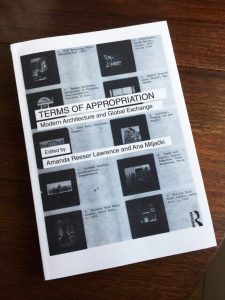
Northeastern University faculty member Amanda Reeser Lawrence, Associate Professor in the School of Architecture, sparks conversations surrounding the exchange of architectural ideas in her new co-edited book entitled Terms of Appropriation: Modern Architecture and Global Exchange. The concept for the book was developed from an interest in architectural originals and copies that she shared with her co-editor and former classmate at Harvard’s Graduate School of Design, Ana Miljački. The two chaired a panel on the topic of architectural appropriation at a conference hosted by the Association of Collegiate Schools of Architecture (ACSA) in 2013. This, combined with a publication grant from the Graham Foundation for Advanced Studies in the Fine Arts awarded in 2016, sparked Lawrence and Miljački to chart new territories in researching and connecting with experts in this still unexplored, yet extremely relevant, topic of study.
The book is a compilation of essays that address how architects borrow, revise, and copy the work of others – and what this means for the discipline and those who are both producing and experiencing the works. The 12 contributors are rising scholars in the field of architectural history and criticism, and their essays investigate how architects engage with their predecessors, and in what ways we can begin to analyze the workings of architectural appropriation.
“We consciously chose the word ‘appropriation’ for the title of the book because it means ‘deliberately taking,’ and purposefully, actively working with the past,” Lawrence explained. “To appropriate is to borrow, reclaim, and rethink, with a focus on the agency embedded in the architect’s reconfiguration of an earlier work.”
The book’s introduction, written by Lawrence and Miljački, explores the choice of the term ‘appropriation’ in more depth, and highlights its distinctions from ‘influence,’ which is inherently more passive and vague. This is just one of the many nuances that come with exploring an overlooked area of study – and ties back to the book’s intent of establishing a shared vocabulary with which to have productive discussions. With its diverse viewpoints and wide-range of historical material, Terms of Appropriation: Modern Architecture and Global Exchange is enabling these important discussions to find their place in architectural discourse.
The four sections of the book provide theoretical categorizations that begin to “chip away at the discomfort initially produced in the marriage of appropriation and architecture.”
Part I, Authorship, explores the figure of the architect, and the concept of anonymity, while Part II, Transfer, tackles the issues surrounding what gets lost in translation. Part III, Rights, looks at the question of law and copying. Lastly, in Part IV, Re-enactments, the authors consider works that shamelessly reference past works, in a way that makes it clear the producers are not only unapologetic, but that they view the copying as a positive, celebrated act.

The relationship between the original and the copy used to be far less tense than it is today. In fact, it was once expected, welcomed, and encouraged that artists and architects would learn by copying the techniques of the master. Fast forward to today, after years of changing opinions and viewpoints on ideas of copying and creativity, the lines that distinguish acceptable inspiration from downright stealing have blurred. This, of course, brings up new questions (and legal considerations) about when a work can be truly considered an original.
“For a work of architecture to be original does not mean that it took absolutely no inspiration or influence from something else,” Lawrence explained. “But the notion of expertise is important. Would the untrained eye be able to see the similarities when comparing two buildings side-by-side? Copyright law uses the ‘ordinary observer’ test, asking whether such an observer would find two works ‘substantially similar.’”
While these types of guidelines may be helpful in copyright infringement cases, they are less useful when considering the ways in which all architecture borrows from earlier works. Just take one of our own local icons, the Boston Public Library, which was copied quite explicitly from the Sainte-Geneviève Library in Paris.
These many variations and examples of architectural appropriation are just some of the reasons that Lawrence finds the topic so fascinating and worthy of continued study and research. While her co-edited book is now published, the conversations are just beginning, especially when considering how today’s technological age has impacted the way people share photos, information, and ideas. There is still much more to discover when it comes to mapping the relationship of architectural objects to other objects, and to factors like history, geography, and politics. We look forward to seeing where Lawrence leads us in this new, revived conversation.
To check out Amanda Reeser Lawrence and Ana Miljački’s collection, please click here.


